Age of extremes
Few names from history inspire such immediate and emphatic revulsion as that of Nazi leader Adolf Hitler. His hands are stained with the blood of millions killed in the devastation of the Second World War and the horror of the Holocaust.
But Hitler was not born a brutal tyrant, he became one. Explore Hitler's life and discover the road that led to destruction.
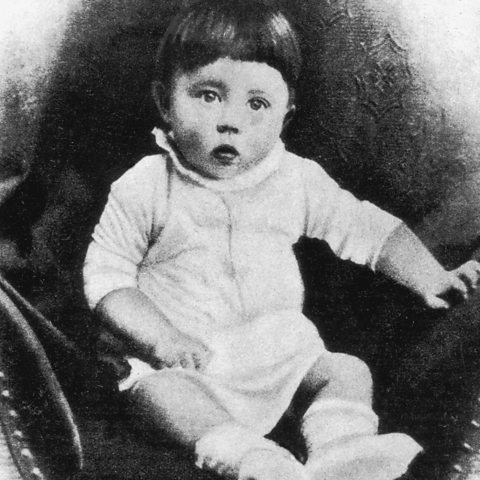
Apr 1889
Birth and childhood
Adolf Hitler was born on 20 April in the small Austrian town of Braunau am Inn, in Upper Austria on the Austrian-German border.
His father, Alois, was a customs official while his mother, Klara, came from a poor peasant family. Life was financially comfortable for the Hitler family but Alois was a domineering character and young Adolf frequently found himself on the wrong side of his father's short temper. At primary school Hitler was a clever, popular child. At secondary school he withdrew psychologically, preferring to re-enact battles from the Boer War than study. He left school with no qualifications at 16.

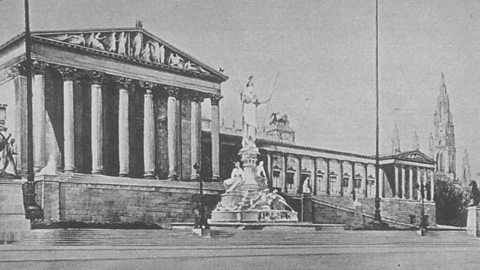
Feb 1908
Down and out in Vienna
Hitler dreamt of a career as an artist. His father had rejected the idea but after he died in 1903 Hitler would try to make his dream a reality.
He applied to the Vienna Academy of Fine Arts but was promptly rejected in October 1907. Shortly after, Hitler's beloved mother died. He moved to Vienna and scratched out a precarious bohemian existence sleeping in hostels and painting postcards. Here he began to develop many of the views which would later characterise his ideology and desire to unite Germany and Austria. The anti-Semitic politics of Vienna's mayor, Karl Lueger, were particularly influential.


Aug 1914
Fighting for the Fatherland
Hitler hated the multi-ethnic composition of Austria's ruling Habsburg Empire. Determined to avoid military service, he moved to Munich in 1913.
Hitler was keen to prove his loyalty to Germany. In August 1914 the world plunged into a war unlike any seen before. Hitler quickly enlisted. In the army he finally found purpose; a cause with which he could wholly identify. Serving in both France and Belgium, he was twice decorated for bravery. In 1916, Hitler was wounded at the Somme, one of the bloodiest battles of the war. Convalescing in Germany, he affected a distinctive toothbrush moustache.

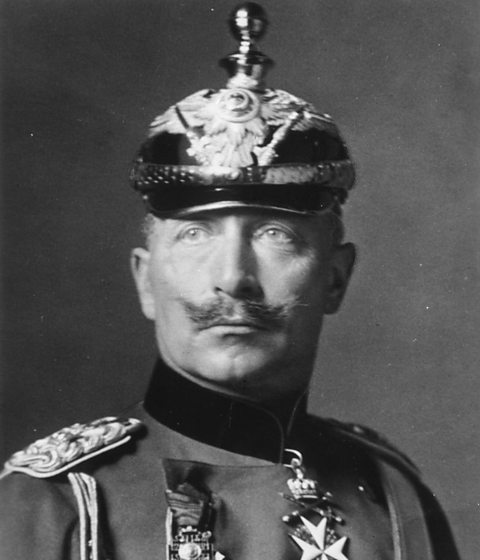
Nov 1918
'Stabbed in the back'
Hitler was wounded for a second time following a British gas attack. While recovering in Pasewalk, the unthinkable happened ŌĆō Germany surrendered.
Before the surrender, facing serious discontent at home and the prospect of defeat at the front, Germany's High Command sought to shift the blame. The majority parties in the Reichstag were handed a poisoned chalice. They were given more power but implicated in the impending defeat. Kaiser Wilhelm II abdicated days before Armistice. Like others, Hitler was enraged by what he saw as the betrayal of an undefeated German Army by Jews and socialists at home. He resolved to go into politics.

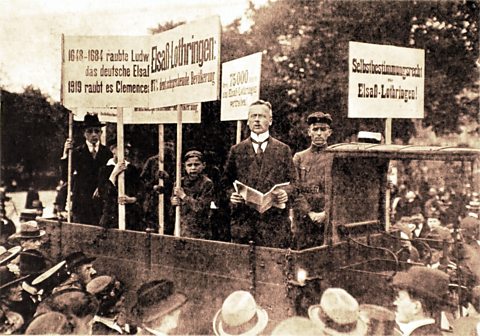
Jun 1919
Treaty of Versailles
To the victors the spoils: when the Treaty of Versailles was signed in summer 1919, Germany was forced to accept sole responsibility for the war.
Just as damaging, the peace obliged Germany to pay large amounts in reparations. The huge loss of territory it also dictated came as a devastating blow. Hitler bitterly resented it. Defeat and then humiliation at Versailles challenged his whole sense of worth. Still in the army, Hitler was sent to report on an emerging far-right group, the German Workers' Party (later renamed the Nazi Party). Finding he agreed with their nationalist, anti-Semitic beliefs, he joined.


Jul 1921
Der F├╝hrer
HitlerŌĆÖs oratory skills helped him rise quickly through the ranks of his new party. In February he spoke before a crowd of nearly 6,000 in Munich.
To publicise the meeting, he engaged in propaganda tactics ŌĆō sending out party supporters in trucks with swastikas to leaflet the area. But the party executive, including founder Anton Drexler, were uneasy at Hitler's growing popularity. In an effort to weaken his position, they formed an alliance with a socialist group while Hitler was in Berlin visiting other nationalist parties. It backfired spectacularly. Hitler promptly resigned and rejoined only when he was handed sole control.

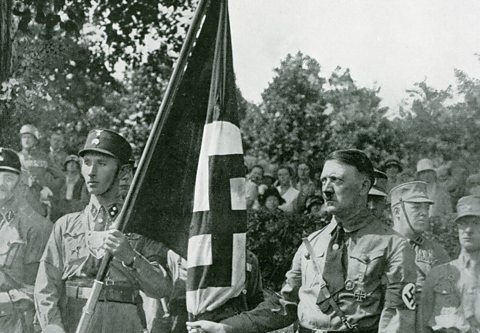
Nov 1923
Beer Hall Putsch
GermanyŌĆÖs government was on the brink of collapse. Hyperinflation saw the price of a loaf of bread rise from 250 marks to 200 billion by November.
Hitler sought to start a revolution. On 8 November, Bavarian Prime Minister Gustav Kahr addressed a meeting of businessmen at a beer hall in Munich. Hitler burst in with his storm troopers (the SA) ŌĆō a motley crew of far-right paramilitaries. At gunpoint, Kahr was forced to pledge support. The next day, Hitler led 3,000 men onto the streets. But the police were waiting. In the ensuing violence, 16 Nazis and 3 policemen died. Hitler was arrested and sentenced to five years in prison for treason.

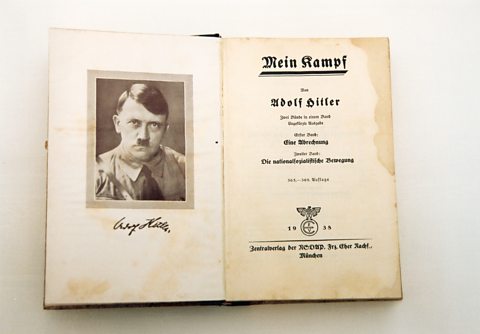
Jul 1925
Mein Kampf
Hitler served just nine months of his sentence in the Bavarian fortress of Landsberg am Lech. Here he wrote Mein Kampf, defining his political vision.
For him, the state was not an economic entity but racial. He declared the superiority of a white Aryan race, with particular vitriol reserved for the Jews he viewed as "parasites". Their elimination, he said, "must necessarily be a bloody process". Mein Kampf outlined the central tenets of a Germany under Nazi control ŌĆō military expansion, elimination of "impure" races and dictatorial authoritarianism. After its publication in July 1925, the book saw more exposure for HitlerŌĆÖs views.


Oct 1929
Wall Street Crash
After the failure of his revolution Hitler looked to the ballot box. But despite his own rising profile, in 1928 the Nazis won just 2.6% of the vote.
A resurgent German economy had seen public opinion move to the political centre. Events on the other side of the world would change all that. When the American stock exchange collapsed, the foreign loans on which Germany's economic recovery relied were called in. Unemployment rose to six million and parties on both the extreme left and right saw support skyrocket. At the same time, Hitler first met a 17-year-old German Catholic girl called Eva Braun.

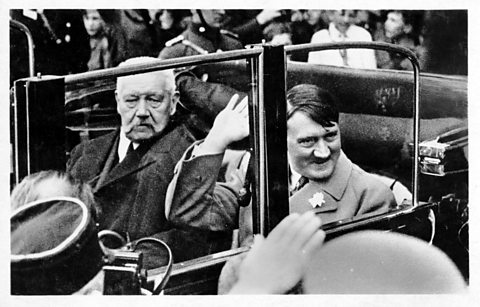
Jan 1933
Leader of Germany
Now a German citizen, Hitler led the Nazis to become the largest party in Germany with over 37% of the popular vote in the elections of July 1932.
German President von Hindenburg's concern at growing Communist support persuaded him to give Hitler the post of Chancellor in January. Hitler quickly consolidated his position. By March he had dictatorial powers courtesy of the Enabling Act, which allowed him to pass laws without Reichstag approval. Political parties, organisations and unions unassociated with the Nazis were soon disbanded. But Hitler still needed the support of the army to fulfil the vision he had outlined in Mein Kampf.

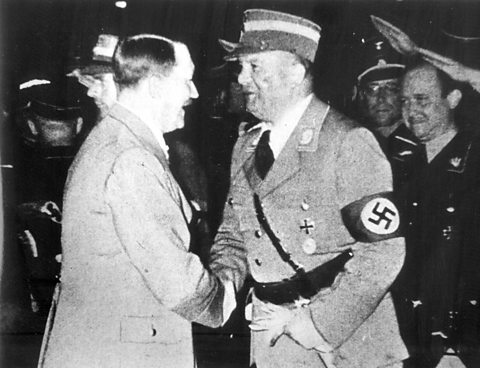
Jun 1934
The Night of the Long Knives
Army leaders were wary of the paramilitaries who had helped Hitler to power. He allayed those concerns ruthlessly, tightening his own grip on power.
The leader of the SA, Ernst R├Čhm, was among hundreds assassinated in one night as Hitler purged his party. R├Čhm's commitment to 'continuing revolution' was not conducive to Hitler's own ambitions. He could not tolerate opposition to his plans to suppress workers' rights and make Germany ready for war. The army, however, approved and after President Hindenburg died in August, they supported Hitler's elevation to F├╝hrer. Hitler was now in total control.

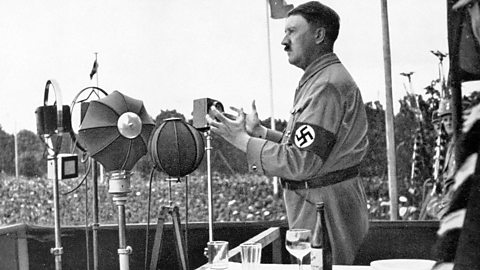
Sep 1935
Nuremberg Laws
Since 1933 the Nazis had tried to exclude Jews and other 'undesirables' from public life. In 1935 a new phase began ŌĆō enforced biological segregation.
At the annual Nuremberg rally Hitler announced laws denying Jewish people citizenship and prohibiting marriage or sexual relations with people of "German or related blood". Anyone with three or more Jewish grandparents was affected, irrespective of their own religious identity. Hitler characterised the laws as an effort to "achieve the legislative regulation of a problem which, if it breaks down again, will then have to be transferred by law to the National Socialist Party for final solution".

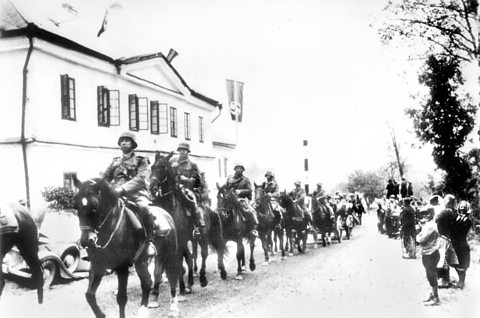
Sep 1938
Appeasement and expansion
With his vision under way domestically, Hitler set his sights beyond Germany's borders. Lebensraum ŌĆō territorial expansion ŌĆō was next on his agenda.
In March Hitler triumphantly led Nazi troops into Austria, achieving his goal of unifying the country of his birth and the country he ruled. His next target was the Sudetenland in Czechoslovakia. Convinced that neither Neville Chamberlain, the British prime minister, nor his French counterpart Edouard Daladier wanted war, Hitler pressed his demands. At a conference in Munich organised by Chamberlain, those demands were met. Nazi troops marched into Czechoslovakia and took the Sudetenland.

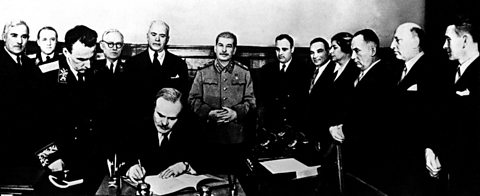
Sep 1939
The gambler
Spurred by his success at Munich, Hitler looked east to Poland. But first he had to make a deal with Stalin's USSR.
Hitler was willing to set aside his hatred of Communism for strategic gain. The two powers agreed the Nazi-Soviet non-aggression pact in late August. Hitler believed his path was clear and on 1 September the invasion of Poland began. It was a gamble ŌĆō the German Army was not yet at full strength. But Hitler was confident Britain and France would not go to Poland's aid any more than they had for Austria or Czechoslovakia. He was wrong. Britain and France declared war on 3 September.

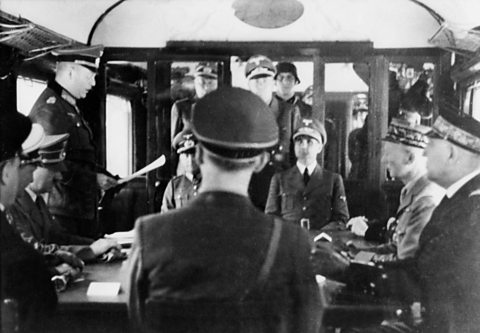
Jun 1940
Hitler's revenge
Though he'd lost the gamble, Hitler was winning the war. Poland fell quickly. The Blitzkrieg tactics of the German Army destroyed all before them.
When France surrendered on 17 June, Hitler took revenge for the German defeat more than two decades before. Hitler ensured the French submission should take place at Compiegne, in the same train carriage Germany had been forced to sign the Armistice ending the First World War. There, in a forest clearing, stood a monument to that day: "Here on the 11th of November 1918 succumbed the criminal pride of the German EmpireŌĆØ. At the scene of Germany's greatest humiliation, Hitler now stood in triumph.

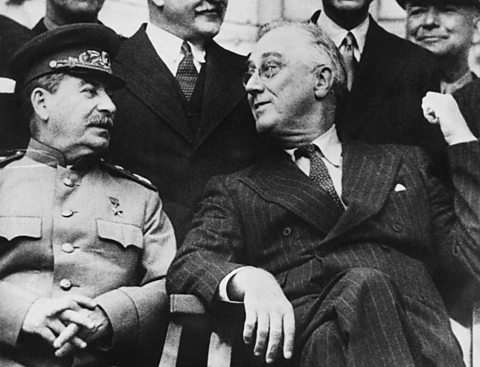
1941
New enemies
Despite the Nazi-Soviet Pact, Hitler retained a staunch hatred of Communism. Extension of Lebensraum in the east was always his ultimate aim.
Hitler was extremely suspicious of Stalin. He'd initially planned to complete the subjugation of Western Europe before turning to the Soviet Union. When Soviet troops occupied the Baltic States, he decided to invade. Hitler was convinced the Red Army could be defeated in a matter of months. He was wrong. He compounded his error by declaring war on another powerful enemy, the US.

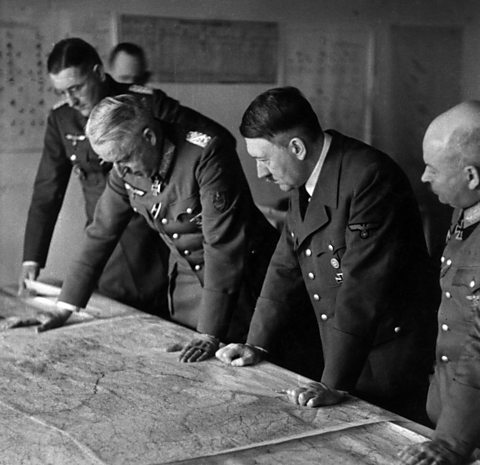
Feb 1943
A wrong turn
As the German invasion of the USSR foundered, Hitler assumed day-to-day operational command of the army, convinced only he could succeed.
Hitler was now directing the entire army from his headquarters, thousands of miles away. In spring 1942 he was convinced the Soviets would be defeated if his army followed his plan to the letter. He was proven wrong at Stalingrad. Freezing, starving and hopelessly outnumbered, German forces could not hold the city. "Surrender is forbidden," Hitler said. His commanders on the ground chose to ignore the order. For the first time Hitler faced sustained personal criticism because of the defeat.

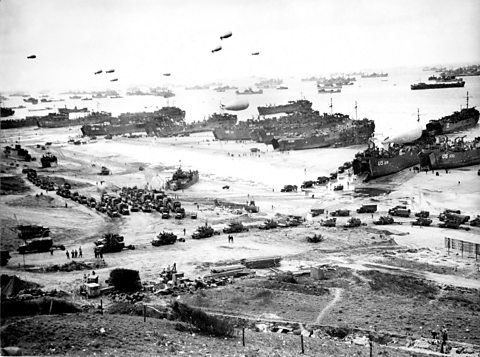
Jun 1944
Asleep at the wheel
Hitler's intransigence had left German forces in retreat in the east. Now, his mistrust and refusal to delegate cost them dearly in the west.
When Allied troops landed on French soil on D-Day, Hitler was asleep in his Eagle's Nest retreat. No significant decisions could be taken without his authorisation. Crucial German panzer divisions which may have delayed the Allied invasion could not be moved until Hitler woke up. The landings were a success. Germany was now fighting and losing a war on two fronts. Yet Hitler had met the news with enthusiasm, believing his forces could finally take the US and Britain out of the war.

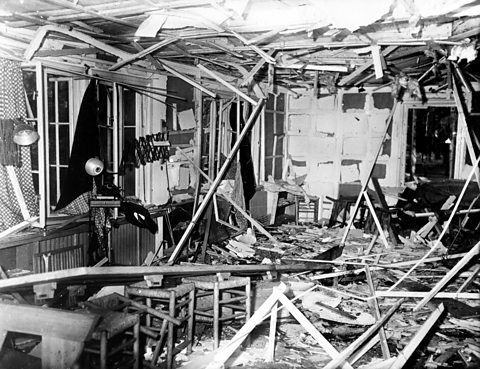
Jul 1944
A weakening grip
As Germany's military situation deteriorated, opposition to Hitler grew among the army elite. Many of his previously loyal commanders wanted him dead.
Hitler was increasingly paranoid, and frequently modified his schedule at the last moment. But on 20 July an opportunity came at last. Hitler was meeting with top military aides at the Wolf's Lair field headquarters. A senior army officer, Lt Col Claus von Stauffenberg, left a bomb in a briefcase in the conference room. At 12.42 pm it went off. A stenographer and three officers died. Hitler was lucky to escape with only minor injuries, shielded from the full force of the blast by an oak table.

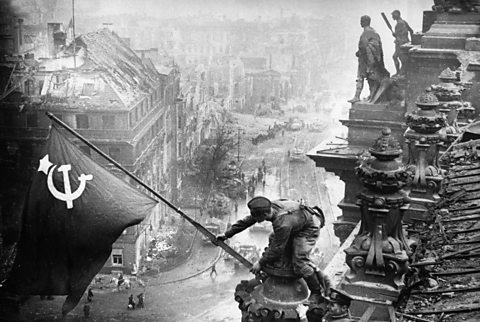
Apr 1945
Defeat and death
As Soviet troops closed in on his bunker in Berlin, Hitler accepted the inevitability of his defeat. He set into action his plan to take his own life.
Hours beforehand, he married Eva Braun, who had remained by his side for 11 years. They were wed early on the morning of 29 April. The next day, at a little after 3.30 pm, they bit into thin glass vials of cyanide. Hitler then shot himself through the head. The man responsible for untold suffering, who had almost single-handedly brought the world to the very brink of destruction, was dead.

Learn more about this topic:
WW2: How did Britain hide its treasure from the Nazis? document
A look at the secret WW2 plan to save Britain's most valuable heritage from the Nazis and bury the priceless artworks underground in Manod, North Wales.
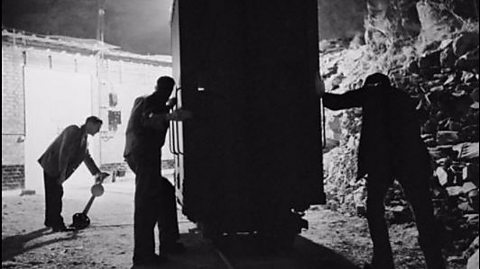
WW2: What would you have done when the bombs fell? document
The Blitz of WW2, sometimes known as the London Blitz, was the German bombing campaign that lasted eight months and targeted 16 British cities.
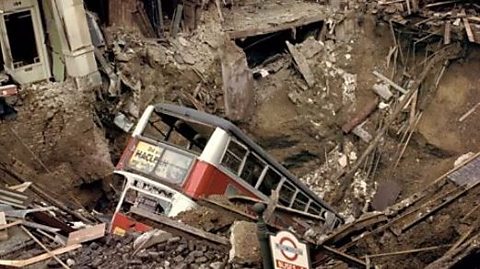
Joseph Stalin: National hero or cold-blooded murderer? document
StalinŌĆÖs name meant "man of steel" and he lived up to it. He oversaw the war machine that helped defeat Nazism and was the supreme ruler of the Soviet Union for a quarter of a century. Learn about the man that began life as the son of an alcoholic cobbler and a doting mother who sent him to study to be a priest.
